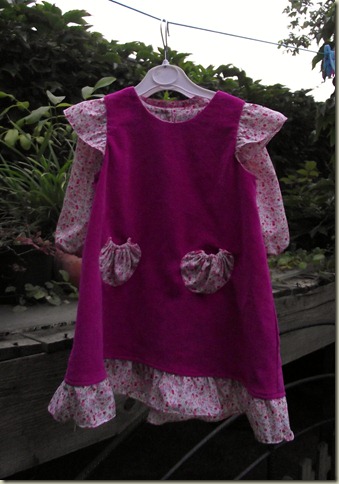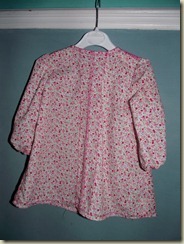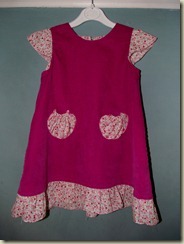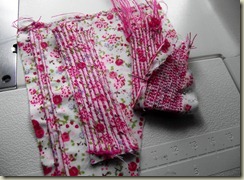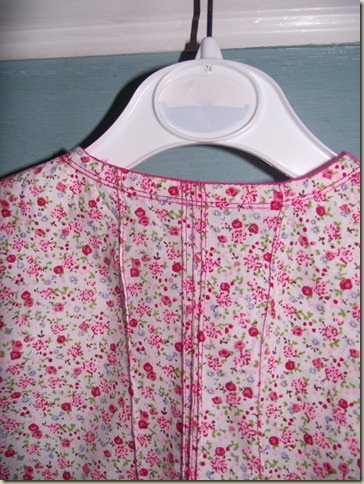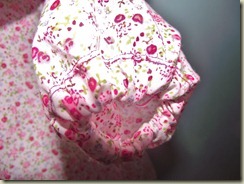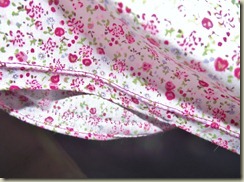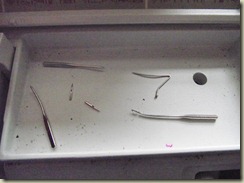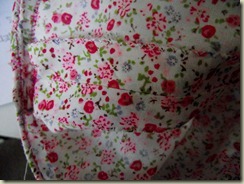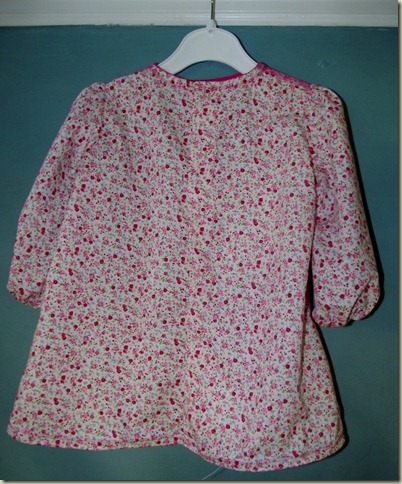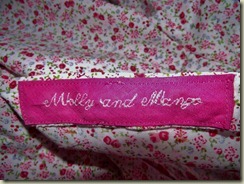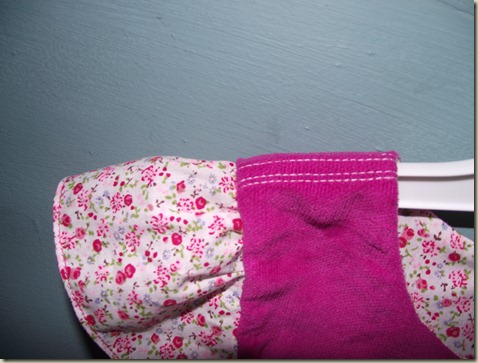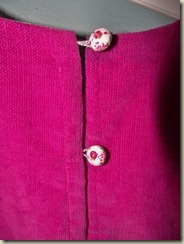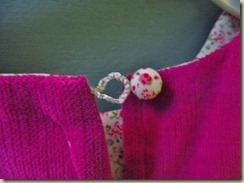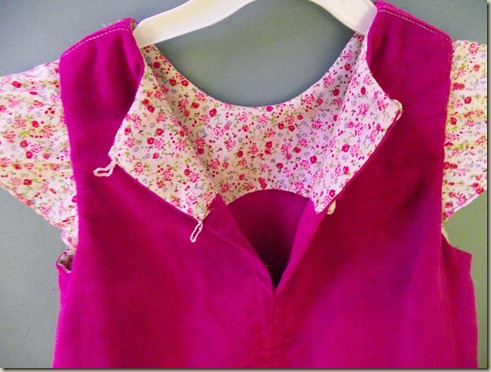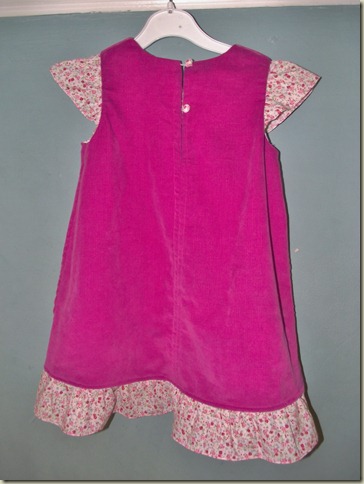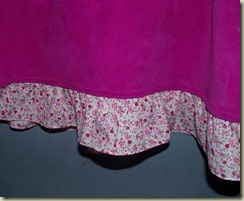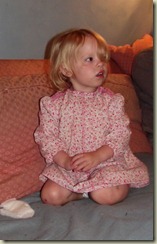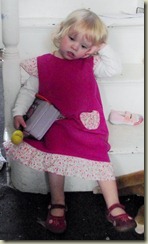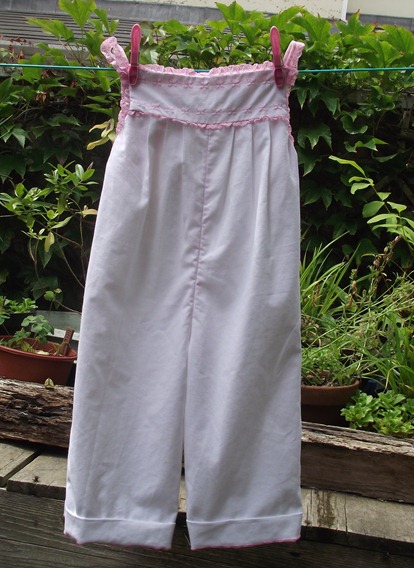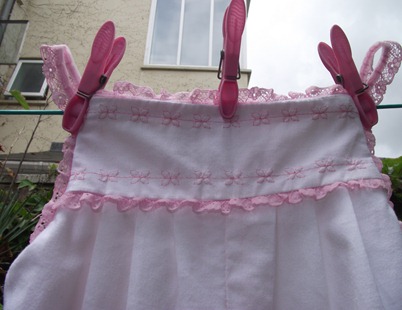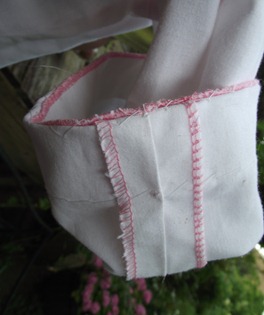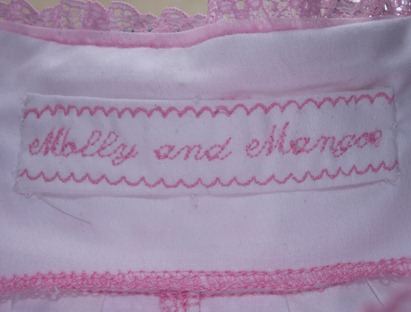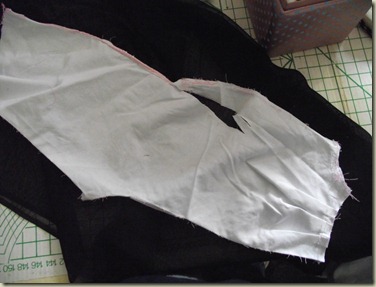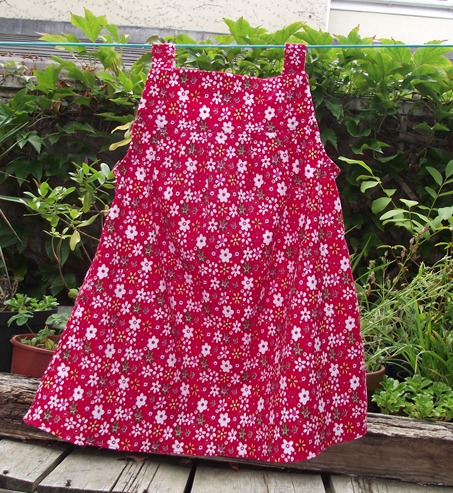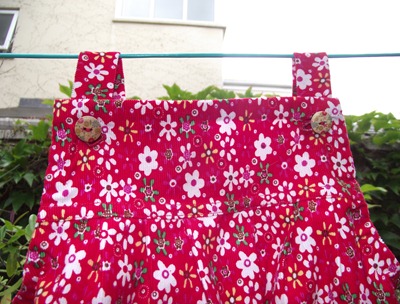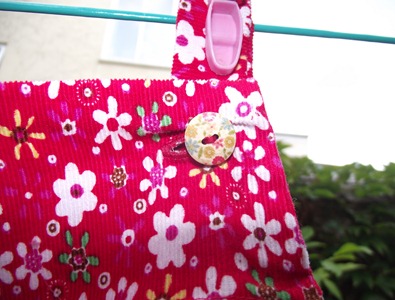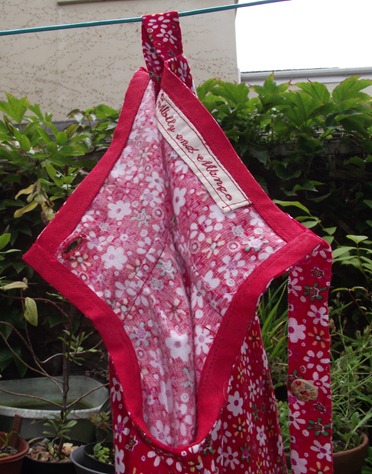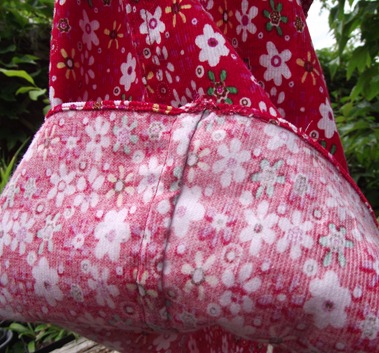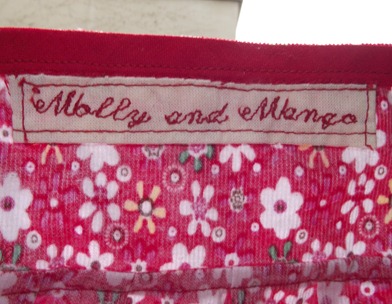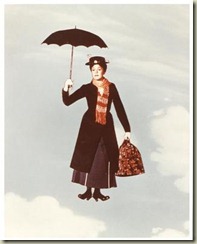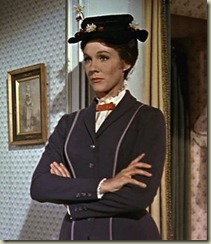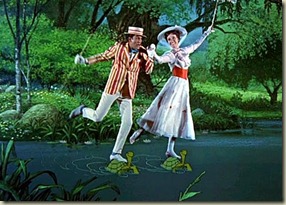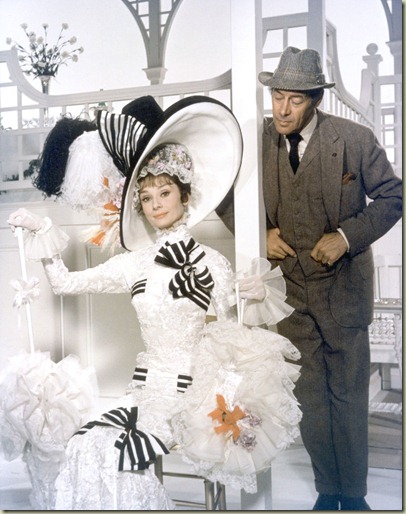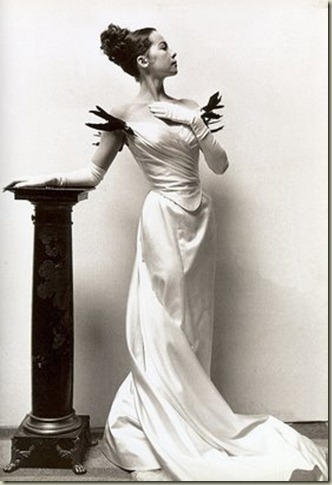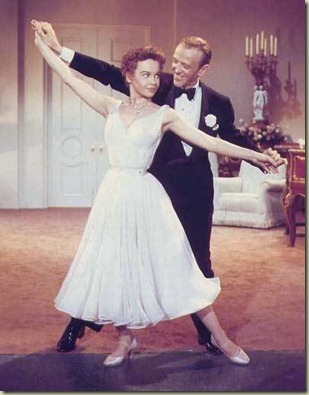8 December 2011
Where did Autumn Go?
But you can take the sewer away from the sewing but not the sewing away form the sewer, I'll be dabbling in costume and there will be pictures... my fairies for example are costumed in chiffon gowns from a vintage 60's night-dress pattern, the heroine of the show will be resplendent in a mock-tudor gown based on a 1980s prom dress pattern... My personal costume challenge came from taking the designer's ideas and creating patterns simple enough that the group can produce them with little expertise, time and budget. Its required a lot of planning and creative thinking, but very interesting sourcing patterns that the team can adapt and giving 20 minute lessons in how to produce certain style features or garments! I look forward to sharing it all in the new year! Seasons Greetings to you all!
31 August 2011
Even More Mango Spoils...
The elasticated cuffs and top-stitching on side seams. The hem is folded twice so I can let it down as Miss Mango grows. The pattern uses casing but the double hem is sufficient to do the same task for now. All I have to do now is persude Miss Mango to try them on. She is getting very particular about what she wears and the last pair of dungarees remain a firm no. Sometimes even if she screams while I dress her she is okay after the clothing is on. With those dungarees, no way, she's trying to peel them off again. Kick in the teeth, much!
28 August 2011
More Mango’s Spoils!
I continue with my mission to bulk up the wee girl’s wardrobe with ample prettiness. This blog brings you more needlecord and some sugary sweet floral action. And a lot of pink. Quite frankly a deluge of pink!
Here’s the pattern: Its a simple long-sleeved A-line dress and a pinafore dress (with or without ruffle trims) and worn either together or separate. Its aged 18 months, madam is 24 months so out came the grading ruler and greaseproof paper and I graded it up (and as she’s “small” for her age that means ample growing room!).
I made both views to complement each other, but also to be worn separately. I chose to make the dress a tunic length blouse instead so she could wear it over jeans. Especially since most of summer has gone now! My mother made me a whole collection of simple frocks in different colour floral fabrics when I was a tot, so it gives me some nostalgia to do the same for my daughter!
I’m trying to add a little embellishment of different types to each project (oil those rusty techniques!) and for the blouse I chose twin-needle top-stitching and pintucks, a favourite of mine, especially for children’s clothes.
L-R: Defined pintucks (sewn over fine cord) – Narrow stitching using twin needle and pintuck foot as guide over double layer of fabric – Semi-defined pintucks using just foot & twin needle and some tension in single layer fabric.
I used my 7 groove pintuck foot and 2.0mm twin needle. The center front pintucks of the blouse are stitched two groves apart over embroidery thread to add definition and texture. [I’ve been trying to get a pintuck blade that adds shape without thread. Finding the Holy Grail might prove an easier task.]
The shoulder details aren’t pintucks but a narrow top-stitching effect done with the 7G pintuck foot as a guide for the twin needle (because they’re stitched over the seam fabric the fabric pulls taut and needs help for definition such as cord, thread or blade).
I kept the twin needle top-stitch theme going on the cuffs, hem and neckline which is also finished with bias tape in hot pink just peeping over the top.
The hem is double rolled using the hemming foot included with my machine. I discovered the hard way that it couldn’t cope with double hemming over the seams by smashing two needles. I ended up doing those sections by hand then top-stitching them on the machine to look consistent.
And talking of seams, I pretty much made this dress back to front. Not in the “oh no, where’s the seam ripper?” sense but in that I first finished off all the edges of the pieces with the overcast foot on my machine before sewing them together(yup, just couldn’t be bothered to thread up the serger). Its not as neat as serging, but it looks cute all the same and reminded me of dainty hankies.
In the photo you can just make out the zigzag stitches on the hem where I hand-basted them then top-stitched over the hem with pink thread on the machine.
Instead of fastening the blouse with buttons, I opted for snaps. This was for two reasons, the first that I couldn’t find any buttons that suited it and secondly because I was already thinking snaps would make life a bit easier. I find buttons on children’s clothing quite frustrating. Most days I struggle to get a top onto Miss Mango, never mind try to do up the buttons while madam wriggles around and tries to escape. Snaps just seem so much easier. If I find good buttons I might add some mock ones onto the back.
And to finish off, a Molly and Mango label, this time on bias binding. I wasn’t going to make one for the blouse, didn’t feel like it needed one but I talked myself into it:
The pinafore dress is hot pink needlecord (from someone’s stash clear-out on eBay) and the ruffle details are in the same fabric as the blouse as is the self-covered buttons (yes, I did use buttons this time).
I echoed the narrow stripe top-stitching on the shoulders only.
The self-fabric buttons are fastened with thread loops. Do modern patterns still use these? I love the fact that the instructions give no aid at all to how thread loops are made, they just expect you to know. But they are easy-peasy and quite therapeutic too, reminds me of the cat’s cradle type games I played as a kid. I could sit for hours making long chains of these, maybe I need to take up crochet!
I felt inspired to break up the sea of hot-pink with more detailing in the form of pockets. I made these from the pattern piece used for the sleeve ruffles. I used a rolled hem on the whole piece. I ended up hating these pockets and I still don’t like them now, thoroughly put off trying them again!
My intention was to sew elastic thread along the top to make the gathered opening stretchy but after turning the sewing room upside down, I cannot find my elastic thread. In the end, I made a casing for narrow elastic which works fine but then I had a helluva time trying to get them look symmetrical.
The facing is also in floral fabric (I love pretty contrast facings). I did not manage to sew the sleeve ruffles into the facing section. Okay I did, but it was because I was stewing over why the instructions said to sew the facing at the neck only, press in 5/8 around the shoulders and sides then flip to wrong side of fabric and hand slipstitch the facing in place around shoulders and sides. Sounds like a lot of unnecessary work and I proved that by machine stitching the facing down then pulling the back pieces through under the facing to flip the garment right side out. Worked perfectly fine. (Except for sewing the sleeve ruffles into the facing…).
I love the sleeve ruffles, such a cute vintage detail, almost every girl’s pattern from the 40s and 50s seem to offer it as an option as well being popular well into the 70s. It often makes an attractive detail on ladies’ patterns of the 40s but I’m not quite sure that is a look a grown woman could pull-off? What do you think? Would you?
I didn’t enjoy sewing the ruffle trim either. Gathering and ruffling is my sewing nemesis. I’d happily sew in a hundred zips of any variety and do another 100 buttonholes than gather or ruffle, I’ve decided! I’ve had no success with the monster ruffling foot and the gathering foot has failed to impress me. I guess I must battle on though as they make a great detail.
The verdict? While Miss Mango said “Oooooooooh! Wowwwww!” (Not the most verbose two-year old I know, probably a good thing!). She immediately insisted on wearing the blouse, despite it being almost bedtime and wore it for two days in a row, its gone for its inaugural wash now, covered in yoghurt, orange juice and whatever else two-year old’s roll in! The pinafore dress is made of sturdy stuff and successfully survived its first wearing too!
Its heartening to see her like these so much, she flat out refuses to wear the uber-cute pink and white dungarees I made her [which are now pink and pink after my mum did some laundering for me…. ![]() ] and another pair of trousers I made earlier in the year. Its actually really hurtful when a toddler throws a hissy fit because she does.not.want.to.wear.what.you.made.for.her! Just wait until you’re old enough to understand emotional blackmail, Mango!
] and another pair of trousers I made earlier in the year. Its actually really hurtful when a toddler throws a hissy fit because she does.not.want.to.wear.what.you.made.for.her! Just wait until you’re old enough to understand emotional blackmail, Mango!
6 July 2011
Mango’s Spoils
I’ve been making clothes for Miss Mango using the first of my fabric fandango purchases and I’m pleased to find I’m still as fond as ever of making children’s clothes.
They’re a relatively quick fix, from cutting to finished in a couple of hours, if you’re not doing anything too fancy (me, I can’t recall the last time I made something just the way the pattern tells you). And they look just so goddam cute, you can’t help but smile at the end result.
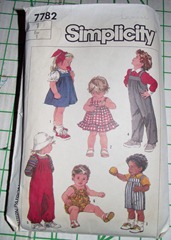 I have been using vintage Simplicity 7782 printed 1986. The original pattern is for a “size 1”, Miss Mango is a size 2 so I had to grade the pieces first, relatively quick and painless. I cut the dungarees and jumper dress pieces.
I have been using vintage Simplicity 7782 printed 1986. The original pattern is for a “size 1”, Miss Mango is a size 2 so I had to grade the pieces first, relatively quick and painless. I cut the dungarees and jumper dress pieces.
Now I wasn’t 100% confident in my grading, children are tricky because of course they obtain a fair amount of height as well as breadth between the sizes, most of it in the lower body. So I browbeat myself into testing it in plain white cotton first before getting going with my lovely Goldhawk Road fabrics.
The proportions looked okay on the sample garment so I had a lot of fun transforming the “plain white cotton” into something far prettier and testing out some features on my “new” machine along the way (I still can’t get it to make a cuppa, can anyone help with that problem?).
The cotton is lovely, it’s recycled from hotel linen (bought from a charity shop) so its 100% cotton, crisp, weighty without being too heavy, holds its shape well, presses like a dream but holds a thumb crease too and is easy to cut. The best thing about it though is, as I sew, inhaling the scent of fresh laundered hotel sheets (I always love getting into a hotel bed for that very reason). Its two main drawbacks are that pins leave noticeable sized holes and it frays terribly.
I’ve used it a lot in the past for budget costuming and knockabout clothes for Miss M so that I don’t care if they get wrecked!).
So without further ado, exhibit A!
I couldn’t like it more, its so girly and fluffy!
The yoke design:
I embroidered this before construction and stabilised it with scrap pattern tissue. It tears away easily and I poke out the remnants trapped in the design with a seam-ripper (v e r y c a r e f u l l y ! ! ! )
Lace-trim – continuous trim into straps around side and underarm:
Seams and hem finished on serger in contrast colour:
I stitched a little label to match, I can’t get over how “finished” adding a label makes it look:
This garments was a labour of love, although it shouldn’t have been. The lace trim took a while to pin, baste and sew – especially the strap section so that it didn’t get caught in the facing seams. I slip-stitched the facing and turned the hems up before realising that I hadn’t serged the seam edges. How could I not have noticed before, they’re in a different colour! So I undid my handiwork and took the seams to the serger. At 2am this is never a good idea. Even when you tell yourself “5 min job before bed”. Especially when the knife is switched on. Classic serger incident. I say incident, more like massacre.
I managed not to cry and cuss. Just. Removed the affected panel appreciating just how many seams and rows of stitching and serging were involved in the construction and hoping I would be able to substitute the damaged panel without having to take much more apart or it being noticeable! I wisely left it quite a lot of hours before tackling the repair and planned it step-by-step in advance so that I didn’t have to take apart more than I needed to!
Exhibit B is the jumper dress in the lovely red flowery needlecord. This is a great fabric to work with too, again nice weight, cuts and manipulates easily, doesn’t fray. I bought a metre of it and used just half in the dress (instead of cutting facings, I used bias binding).
The wooden buttons:
I had to make the holes horizontal because the foot kept jamming on the yoke seam stitching 5mm buttonholes! (I learned that my lovely machine ain’t too hot on buttonholes anyway after a dozen or so failed attempts. These were both sewn twice, pffft)
Flat-felled seams (yoke and sides – traditional, durable seam for children’s wear), bias tape facing (slipstitched in place on inside) and narrow rolled hem:
Another tailored label:
I’ve been thinking about getting a set of labels pre-woven but I real like colour-coordinating them to the outfit. They take 5 minutes to make on the machine and they make me smile so I think I will carry on making my own.
Before I lay this pattern to rest, I just have the dungarees to make again in their original intended fabric, another floral needle-cord.
N.B. The washing line is modelling these because Miss Mango refuses to for less than 10,000 raisins. At the moment she is refusing to wear clothes full stop and is in David Bailey mode insisting on being the one holding the camera instead of posing nicely. But its probably best that she wasn’t let loose with these clothes before I got to photo them - from experience I know that by the time the camera is warmed up, Miss Mango’s clothes will be submerged under a layer of dirt, ink, food and drink (and me too sometimes)!
5 July 2011
There’s Something about Mary…
I recently purchased for Miss Mango a box set of the Mary Poppins stories. She is a little young for this reading at the moment, but it is one of my favourite children’s books and deserving of a place on her bookcase (and yes, I still read children’s books as an adult, I frequently dip into The Faraway Tree).
It ties in quite nicely with a recent conversation about recreating outfits from movies. I said that one dress that inspired me and that I would like to copy is from the wardrobe of Mrs Banks, her “Sister Suffragette” outfit in yellow and blue.
There is so much I like about it. The pastel blue teamed with the bright yellow, the layers of fluffy chiffon and tulle, the way the petticoat cheekily pokes through skirt front. The velvety soft look of the blue fabric. As a child/teen watching the film, I coveted that dress. I still do, so I’m adding to my list of garments to recreate (one day).
Googling for images was very successful as I found this oh-so-handy set of pictures over at The Golden Closet:
The very garment itself as worn by Glynis John in the film and sold through a memorabilia website. The details say that it is silk chiffon, thats about it. I find the construction very interesting, I wasn’t expecting the petticoats to be part of a full slip nor for the ruffle collar to be attached. I’m guessing the sleeve ruffles were attached directly to the dress itself? I wonder where the slip (and dress) is now?
The site also informs us that costume designer, Tony Walton, received an Oscar nomination for his design. Unsurprising considering how iconic the film’s costumes are, I should think pretty much everyone can instantly conjure up Mary’s image:
Walton’s Oscar opportunity was pipped by Cecil Beaton’s incredible work on My Fair Lady. I think it’s fair to say Walton never stood a chance.
On the subject of Beaton, have you ever heard the story behind another of his famous monochromatic gowns, from the film Gigi?
Leslie Caron, who played Gigi, reminisces: "When he showed me the sketches, I said, 'Wonderful, especially the white satin dress with the black birds.' He said, 'I was drawing ribbons, but if you want birds . . .' So he put swallows on the dress."
Caron stars in a favourite Golden Era film of mine, Daddy Long Legs, with Fred Astaire. If you’re looking for great 1950s inspiration (from cigarette pants to ball-gowns) as well as a bit of sugar-sweet Hollywood indulgence, this film has both in spades as it follows Caron’s character's evolution from orphan to wealthy beneficiary.
Hmm, My Fair Lady, Gigi, Daddy Long Legs, the film-makers of yore certainly loved charting the girl-to-women transition in rags-to-riches storylines!
By the way, if you haven’t read the P. L. Travers, Mary Poppins books I thoroughly recommend them. They’re just full of Poppins magic and charming characters, beautifully tying in gentle moral messages into the behaviour of the children, the film barely scratched the surface.







